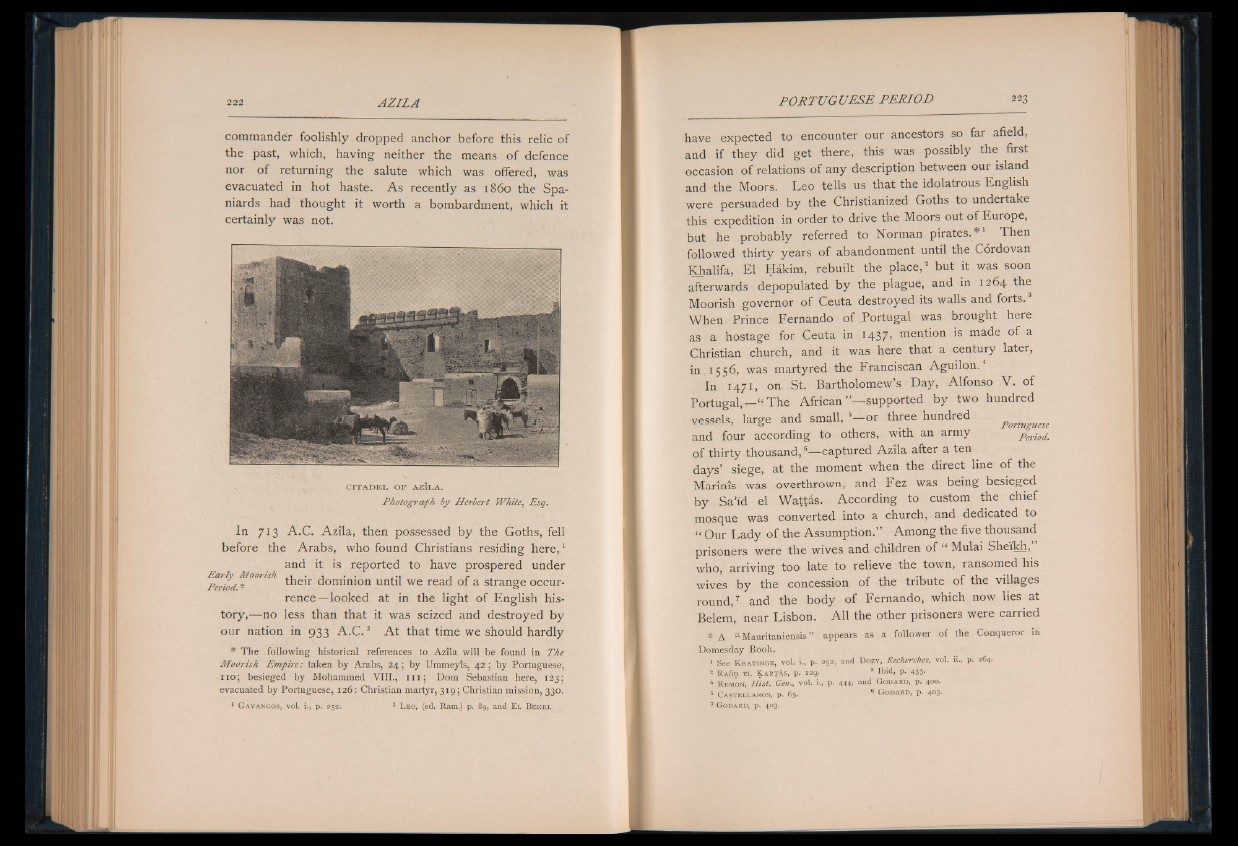
commander foolishly dropped anchor before this relic of
the past, which, having neither the means of defence
nor o f returning the salute which was offered, was
evacuated in hot haste. As recently as i860 the Spaniards
had thought it worth a bombardment, which it
certainly was not.
C ITADE L OF AZILA.
Photograph by Herbert White, Esq.
In 713 A.C. Azila, then possessed by the Goths, fell
before the Arabs, who found Christians residing here,1
and it is reported to have prospered under
Early Moorish 1 • , . . , r
Pe iod * their dominion until we read of a strange occurrence
^looked at in the light of English history,—
no less than that it was seized and destroyed by
our nation in 933 A .C .2 A t that time we should hardly
* The following historical references to Azila will be found in The
Moorish Empire: taken by Arabs, 24; by Ummeyis, 42; by Portuguese,
110; besieged by Mohammed VIII., Ifljw Dom Sebastian here, 123;
evacuated by Portuguese, 126: Christian martyr, 319; Christian mission, 330.
1 G a y a n g o s , v o l. i., p . 252. 2 L eo , {ed. R am .) p . 89, an d E l B e k r i .
have expected to encounter our ancestors so far afield,
and if they did get there, this was possibly the first
occasion of relations of any description between our island
and the Moors. Leo tells us that the idolatrous English
were persuaded by the Christianized Goths to undertake
this expedition in order to drive the Moors out of Europe,
but he probably referred to Norman pirates.*1 Then
followed thirty years of abandonment until the Cordovan
Khalifa, El Hakim, rebuilt the place,2 but it was soon
afterwards depopulated by the plague, and in 1264 the
Moorish governor of Ceuta destroyed its walls and forts.
When Prince Fernando of Portugal was brought here
as a hostage for Ceuta in 1437, mention is made of a
Christian church, and it was here that a century later,
in. 1556, was martyred the Franciscan Aguilon.
In 1471, on St. Bartholomew’s. Day, Alfonso V . of
Portugal,— “ The African’’^-supported by two hundred
vessels, large and small, '— or three hundred Porlvguese
and four according to others, with an army period.
of thirty thousand,6—-captured Azila after a ten
days’ siege, at the moment when the direct line of the
Marinis was overthrown, and Fez was being besieged
by Sail'd el Wattas. According to custom the chief
mosque was converted into a church, and dedicated to
“ Our Lady of the Assumption.” Among the five thousand
prisoners were the wives and children of “ Mulai Sheikh,
who, arriving too late to relieve the town, ransomed his
wives by the concession of the tribute of the villages
round,7 and the body of Fernando, which now lies at
Belem, near Lisbon. A ll the other prisoners were carried
* A “ Mauritaniensis ” appears as a follower of the Conqueror m
Domesday Book.
1 S e e K e a t i n g e , v o l. i., p . 252, an d D o z y , Recherches, v o l. ii., p . 264.
2 R aod e l K a r t a s , p . 129. 3 Ib id , p. 433.
4 R em o n , Hist. Gen., v o l. i., p . 444, and G o d a r d , p. 400.
5 C a s t e l l a n o s , p . 65. 6 G o d a r d , p. 403.
1 G o d a r d , p . 403.